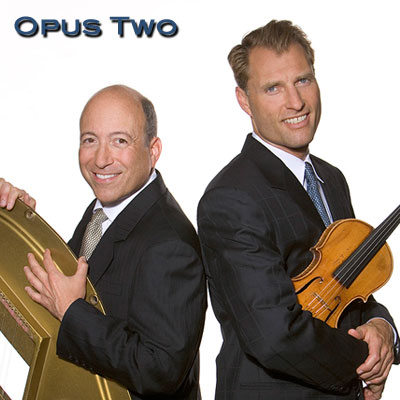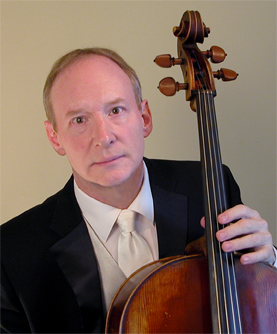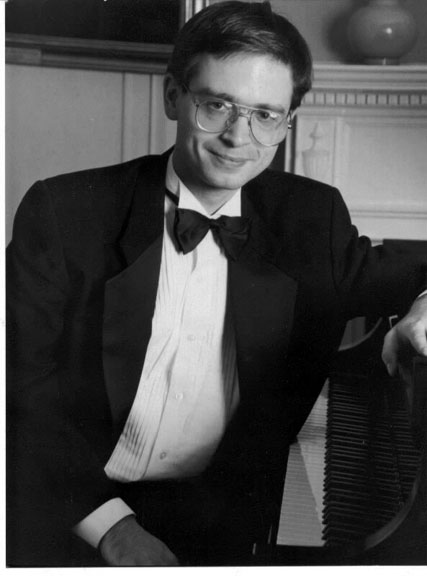On an unusually warm December day, I made my way to the Bruno Walter Auditorium to hear a performance of the music of George Gershwin by the duo Opus Two. I was expecting a smaller crowd because of the holiday weekend and the early afternoon starting time. Imagine my surprise, upon arriving, at the sight of a long line of about seventy people all hoping to get in, even though the hall was already filled! Luckily, my place was reserved. A few other lucky people in this line gained entry and were treated to what was part concert, part lecture, and part sentimental retrospective.
Opus Two boasts the combined talents of William Terwilliger, violin, and Andrew Cooperstock, piano. This well-travelled duo with performances around the globe is especially renowned for championing American music and composers. What could be more American than the works of George Gershwin? Opening with Jascha Heifetz’s arrangement of “Summertime”, from Gershwin’s masterpiece Porgy and Bess, the duo gave the audience a taste of what was to follow. The performers then introduced themselves and alternated turns at the podium as they spoke of Gershwin. They included a few well-known anecdotes, including the oft-quoted one from Maurice Ravel (when Gershwin sought composition lessons from the French genius): “Why do you want to be a second-rate Ravel when you are already a first-rate Gershwin?” It was time for the concert proper to commence.
First up came Selections from Porgy and Bess as arranged by Jascha Heifetz. The renowned Heifetz had been quick to recognize the appeal of Gershwin’s music and was savvy enough to capitalize on that demand by making arrangements that highlighted his own virtuosic talents. Porgy and Bess is the best known of these arrangements and continues to delight listeners to this day. The playing from Opus Two was assured, from the restless “Summertime” (yes, again), to the laments of “My Man’s Gone Now”, to the joyous “Bess, You is My Woman Now’, to the biting irony of “It Ain’t Necessarily So”. Images by African-American period photographer, Richard Samuel Roberts, were projected on a large screen behind the performers and were a perfect visual accompaniment to the music. It reminded me of the style of Ken Burns in his various documentaries and was an inspired touch. This was the sort of imaginative conception that one hopes for, even expects, when two exceptional musicians who really are of the same mind and spirit join together. Opus Two fulfilled this expectation throughout the concert.
Short Story, for Violin and Piano, was the only work originally written for this combination by Gershwin himself. The violinist Samuel Dushkin, a friend of Gershwin and a renowned performer in his own right (Stravinsky wrote his Violin Concerto for Dushkin in 1931), offered technical advice on the violin part. Gershwin and Dushkin premiered this three-minute work, which has all the hallmarks of Gershwin’s style- rhythmic vitality and catchy tunes (in this case laced with the blues and ragtime). But, for whatever reason, it never caught on with other performers and disappeared in oblivion. While admittedly not up to the standards of his later mature works, it is still worthy of attention, and the fine performance from the duo made that point clear. Kudos to Opus Two, for both their sophisticated reading and for sharing this little-known gem, which should gladden the heart of any Gershwin fan.
The Three Preludes for Piano, also arranged for violin and piano by Heifetz, followed and were played with stylish assurance. While I prefer the original, this arrangement was highly effective.
Excerpts from An American in Paris, which were partially arranged by Heifetz and later expanded by Ayke Agus in 2005, were introduced by a short talk and video selection from the movie featuring Gene Kelly and Leslie Caron dancing a pas de deux (as choreographed by Kelly) to set the mood. The players’ casual commentary included the remark, “They don’t make them like that anymore!” No, they sure don’t! Violinist William Terwilliger joked about how he would be simulating the sounds of car horns with his violin. This work shows the ever-maturing Gershwin’s progress from song plugger to “serious” composer, with French influences (Debussy and Ravel), yet in his own highly characteristic voice. Opus Two played with appropriate elegance and wit in yet another winning performance.
Composer Eric Stern continued the Heifetz tradition with his own arrangement of Selections from Girl Crazy, written especially for Opus Two. Another video, this time Judy Garland singing “Bidin’ My Time” from the movie version of Girl Crazy, was played and brought smiles to all as a reminder of a golden age. Returning to their performance, Opus Two presented Stern’s arrangement with panache. Including the unforgettable classics, “Embraceable You” and “I Got Rhythm”, this transcription was destined to be a crowd pleaser. The same energy and commitment with which the duo started the concert were still very much in effect, in even more refined playing. The lazy drawl of “Bidin’ My Time”, the enchanting “Embraceable You”, and an electric “I Got Rhythm” ended the piece and the concert in triumph. The audience demanded more, so for an encore, Opus Two offered a favorite from another one of America’s most loved composers, Aaron Copland, “Hoedown” from Rodeo. Played with brio, it was a fitting close to a most enjoyable concert.



